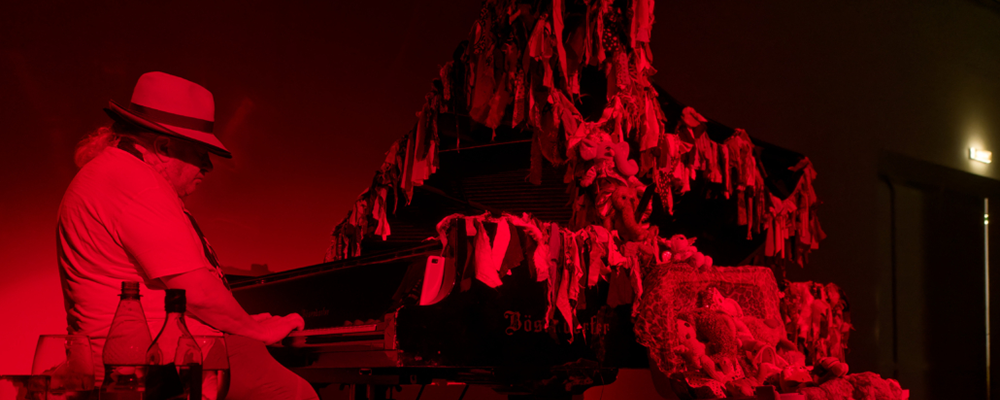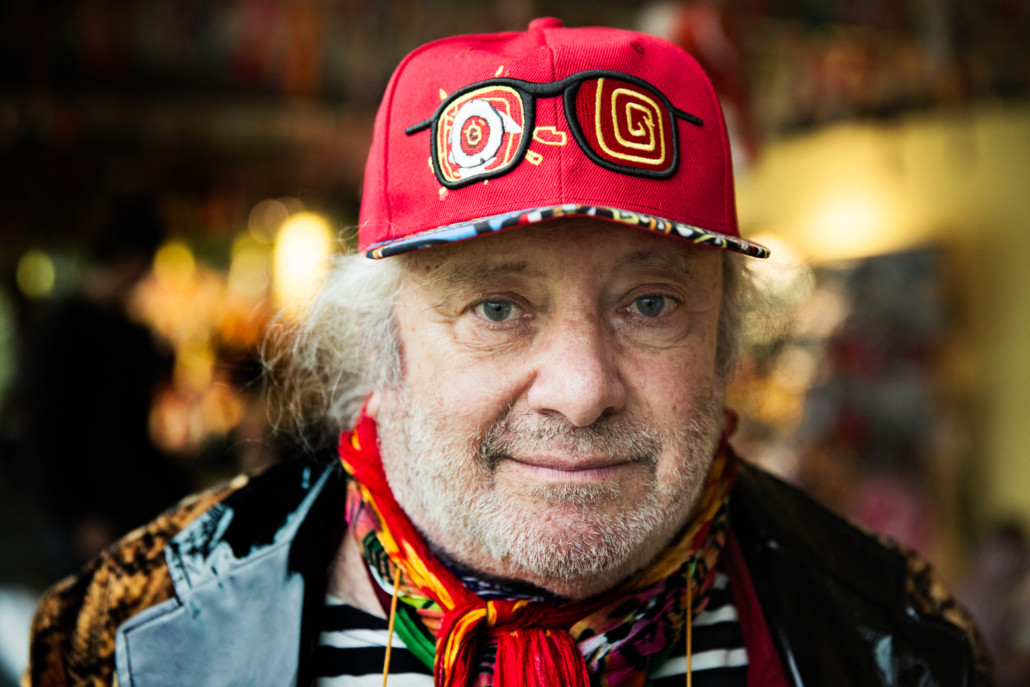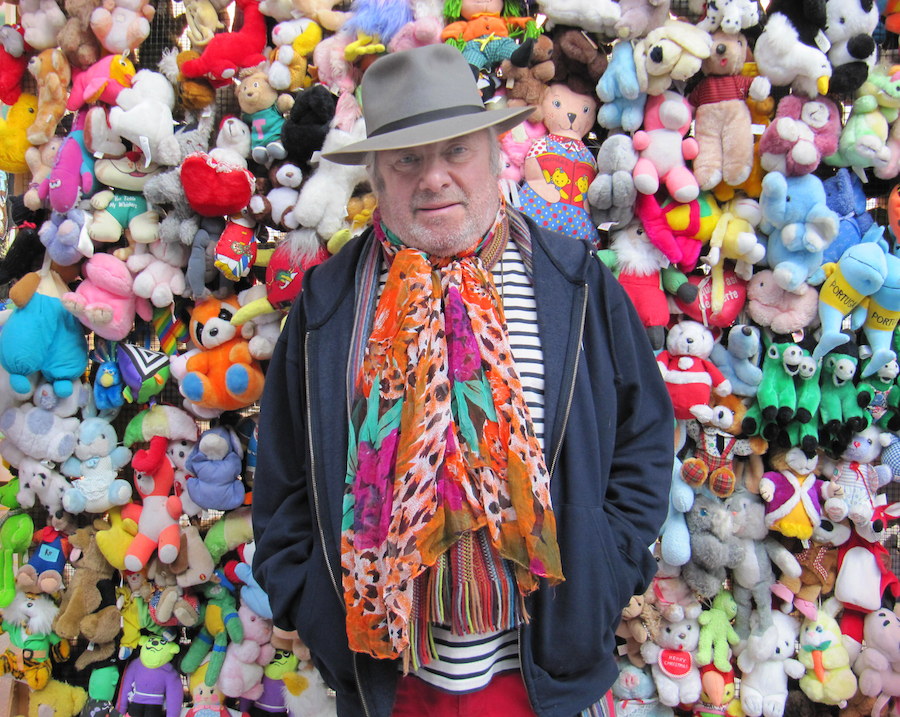Fredagar på Sibbe: Charlemagne Palestine

Standard price 25€ (+service fee)
Students/ pensioners/ children 15€ (+service fee)
The Sibelius Museum and the Museum of Sound* will present a special performance of Charlemagne Palestine in the concert hall of the Sibelius Museum in Turku. The concert also celebrates the 50th anniversary of his work “Strumming Music”.
The experimental artist and composer Charlemagne Palestine (b. 1947) is a living legend and has been part of shaping sound performances in art and experimental music. Palestine was part of the experimental music and art scene in New York in the 60s together with colleagues such as Tony Conrad, Pandit Pran Nath and the filmmaker Kenneth Anger. He has made several performances in collaboration with the acclaimed dancer and choreographer Simone Forti. He uses instruments such as organs, carillon, the grand piano and toy machines. His performances are installation-like and include soft toys, teddy bears and textiles. The soft toys and teddy bears are a key component in Palestine’s work, serving as co-performers and are individuals in their appearances.
His performances can be characterized as soulful and expressionist, through sounding drones, whereas the sound functions as a sculpture in the room.

Charlemagne Palestine was born in Brooklyn NYC in 1947. He is a sound artist, composer, performer, video artist and installation artist. Palestine studied at New York University, Columbia University, Mannes College of Music, and the California Institute of the Arts.
A contemporary of Philip Glass, Terry Riley, Phill Niblock, and Tony Conrad; Palestine creates intense, ritualistic, continuum music for electronic sound sources, bell carillons, pipe organs, pianos, voice and other keyboard instruments since the sixties. A composer-performer originally trained to be a cantor, and then a carillonneur; he always performs his own works as soloist. His electronic continuums were his first major pieces. He early on began developing sonorities especially with large numbers of electronic sound oscillators and filters developed by Moog, Buchla, Serge, Arp and Oberheim. These sonorities lasted from several hours to days exploring slow gradual timbral color transformations and beat tone variations creating what he termed his “Golden Sonorities” or the search for the Golden Sound. His continuum form “Strumming” for amplified pianos, develops harmonies, dissonances and clusters with a visceral physical force that pushes the sonic limits of a piano till it no longer resembles one, even often naturally detunes from the force and becomes a new kind of multi spectrum electro-acoustic sound emitting machine. His favorite pianos are the 9 foot long Bösendorfer Imperial which has 9 tones lower than any other piano in the world and the Borgato which is a grand piano with 2 bodies; one played with the hands and one with the feet.

His “Schlingen Blängens”, a sonic continuums form for pipe organs where like in alchemy all the different and varied timbral registers of a traditional church or theatre organ are merged and developed searching for the Golden Sound, using a unique continuum key prolonging technique that allows Palestine to create works developing hundreds to thousands of nuances of organ timbres becoming a massive magical sonorous vibrating storm cloud that interacts with the architecture of each church or theatre edifice. As a vocalist in his epic 2 hour long Karenina he sings in a haunting ghostlike countertenor falsetto register and in other works like his sound/motion videos he sings long tones with gradually shifting vowels and overtones while moving through spaces and places while performing repetitive intense shamanic body action rituals such as throwing himself against walls; running and falling in labyrinthal spaces; singing on high speed motorbikes or on roller coasters and other amusement park intense motion rides.
Palestine stopped performing from the early eighties till the mid nineties and devoted himself entirely to his forms of plush animal divinity altars as multi-media sculptures and installations. These altars are always an integral ingredient in Palestine’s performances. Since his return to performing Palestine has reissued works from the sixties and seventies on CD and vinyl, created and recorded many new works and has collaborated and recorded with other musicians such as Pansonic, Simone Forti, Tony Conrad, Rhys Chatham, Perlonex, Gol, among others. He now performs regularly in venues and festivals as well as presenting his multimedia installations worldwide.
Charlemagne lives and works in Brussels, Belgium.
Charlemagne Palestine is considered one of the pioneers of minimalist music, although he refuses to claim this label for himself. His repetitive piano pieces are rather a part of a Gesamtkunstwerk that combines installations and performances. Playing on a grand piano surrounded by stuffed animals Palestine unfolds a sound structure that transforms difference and repetition into complex sound clusters.

*museum of sound
The Museum of Sound is a nomadic and in flux, but will always be rooted in the essence of sound. There is not a specific place where the museum exists. The underlined message of the project is that a museum of sound can exist in varied forms and sizes, either as a physical changing place or on other platforms like the Internet, musical releases or within printed publications. The Museum of Sound has a loose and everchanging network of fellow artists working in the field of art, sound and music.
The initiative for The Museum of Sound -project was the Mika Vainio 50Hz -exhibition at Museum of Contemporary Art Kiasma in Helsinki in autumn 2020. Because of the restrictions to events during the pandemic, The Museum of Sound started by organising so called Listening Rooms in various architecturally and conceptually interesting venues. One of these Listening Rooms was held in Sibelius Museum in December 2021.
The service fee applies to tickets purchased from Lippupiste.